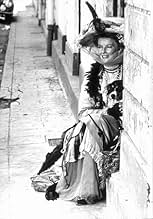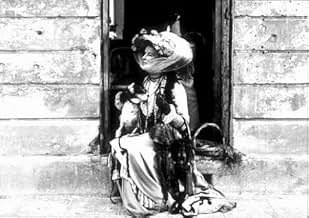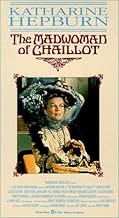NOTE IMDb
5,9/10
1,3 k
MA NOTE
La comtesse Aurélia, sympathique, excentrique, idéaliste et un peu folle, qui croit que le bien doit l'emporter sur le mal, s'oppose aux puissants dirigeants corrompus de Paris en leur faisa... Tout lireLa comtesse Aurélia, sympathique, excentrique, idéaliste et un peu folle, qui croit que le bien doit l'emporter sur le mal, s'oppose aux puissants dirigeants corrompus de Paris en leur faisant un procès .La comtesse Aurélia, sympathique, excentrique, idéaliste et un peu folle, qui croit que le bien doit l'emporter sur le mal, s'oppose aux puissants dirigeants corrompus de Paris en leur faisant un procès .
- Réalisation
- Scénario
- Casting principal
Avis à la une
A wonderful fable I happened to stumble across. The inimitable Katharine Hepburn as the title character conspires with other eccentrics to save Paris. Warm, funny, delightfully non-sequitur and deeply poignant, this film has messages about love, greed, happiness, fear, hope, dreams. . .life. Excellent performances by all, including some wonderful dramatic acting by Danny Kaye. I highly recommend this movie.
Jean Giraudoux who wrote The Madwoman Of Chaillot became a prominent French writer in the years between the two World Wars and died in 1944 a year before this play made its debut on the French stage. Those who were occupying France at the time Giroudoux died would not have wanted this item shown to be sure as it is an indictment against the greed and thoughtlessness of the modern age and the ruthless people in positions of power.
Katharine Hepburn plays the title role, a picturesque old woman who dresses in pre-World War I fashion as an outward manifestation of her rejection of the modern age. She would have looked out of place in 1944, in 1969 she and her fellow senior citizen rebels Edith Evans and Margaret Leighton look even more so. Right at the beginning of the film the age is established for us showing the student protests that rocked France in the late Sixties and we see Kate her best 1913 fashion just gliding through it all.
While she rejects the changing times, some power people who you would not think of at first as allies are meeting at a Paris café plotting to really upset her world in a way she can't escape from. Charles Boyer, Oscar Homolka, Donald Pleasance, Paul Henreid, John Gavin, and Yul Brynner who seems to be taking the lead in the group have discovered that Paris is sitting on a bed of shale with oil deposits that would rival the Middle East as a source. That would certainly make France a power to be reckoned with. In fact Paul Henreid who is a French general makes note of the fact that France has gone its own way politically which at the time Charles DeGaulle was doing, separating himself from America and that accursed island nation Great Britain.
Of course the site of oil derricks in and around those colorful parts of Paris that have their own legend separate and apart from the city as a whole is something that Kate can't permit. The scheme is brought to her attention by a number of the citizens who have overheard bits and pieces at the café and were shooed away. Yul Brynner took an especial delight in doing this.
Hepburn and her fellow mad women formulate a plan and try these people in abstentia. Parisian street character Danny Kaye, the ragpicker who is as far down the economic scale from the conspirators as you can get offers a great defense for them as lawyers do for their clients, but it's a done deal. And she's got an interesting fate in store for them.
When The Madwoman Of Chaillot made it to Broadway in 1949-50 and won a Tony Award for Martita Hunt playing the title role, theater goers then knew of the great Kettleman Hills oil strike which was close to Los Angeles city limits. There are still parts of the area where you can see functioning oil derricks even today. The image of a gusher coming out of a derrick next to Notre Dame or the Arc De Triomphe was really in the minds of theatergoers back then.
Hepburn does well in the part showing that maybe The Madwoman Of Chaillot and her mad friends really have a lot more sense than we might give them credit for. They may have rejected the 20th Century, but they rejected the mass wars that characterized it and the all consuming quest for domination and profits above all. There's still beauty in Kate's world and she'll fight to preserve it.
The Madwoman Of Chaillot might be a bit quirky for some tastes, but Katharine Hepburn's fans will love it.
Katharine Hepburn plays the title role, a picturesque old woman who dresses in pre-World War I fashion as an outward manifestation of her rejection of the modern age. She would have looked out of place in 1944, in 1969 she and her fellow senior citizen rebels Edith Evans and Margaret Leighton look even more so. Right at the beginning of the film the age is established for us showing the student protests that rocked France in the late Sixties and we see Kate her best 1913 fashion just gliding through it all.
While she rejects the changing times, some power people who you would not think of at first as allies are meeting at a Paris café plotting to really upset her world in a way she can't escape from. Charles Boyer, Oscar Homolka, Donald Pleasance, Paul Henreid, John Gavin, and Yul Brynner who seems to be taking the lead in the group have discovered that Paris is sitting on a bed of shale with oil deposits that would rival the Middle East as a source. That would certainly make France a power to be reckoned with. In fact Paul Henreid who is a French general makes note of the fact that France has gone its own way politically which at the time Charles DeGaulle was doing, separating himself from America and that accursed island nation Great Britain.
Of course the site of oil derricks in and around those colorful parts of Paris that have their own legend separate and apart from the city as a whole is something that Kate can't permit. The scheme is brought to her attention by a number of the citizens who have overheard bits and pieces at the café and were shooed away. Yul Brynner took an especial delight in doing this.
Hepburn and her fellow mad women formulate a plan and try these people in abstentia. Parisian street character Danny Kaye, the ragpicker who is as far down the economic scale from the conspirators as you can get offers a great defense for them as lawyers do for their clients, but it's a done deal. And she's got an interesting fate in store for them.
When The Madwoman Of Chaillot made it to Broadway in 1949-50 and won a Tony Award for Martita Hunt playing the title role, theater goers then knew of the great Kettleman Hills oil strike which was close to Los Angeles city limits. There are still parts of the area where you can see functioning oil derricks even today. The image of a gusher coming out of a derrick next to Notre Dame or the Arc De Triomphe was really in the minds of theatergoers back then.
Hepburn does well in the part showing that maybe The Madwoman Of Chaillot and her mad friends really have a lot more sense than we might give them credit for. They may have rejected the 20th Century, but they rejected the mass wars that characterized it and the all consuming quest for domination and profits above all. There's still beauty in Kate's world and she'll fight to preserve it.
The Madwoman Of Chaillot might be a bit quirky for some tastes, but Katharine Hepburn's fans will love it.
10ftparish
Lots of good comment already made except for some confusion over interpreting and understanding allegory. This is one of the best examples. Much has been said about the waste of talent by big name actors in this film. This play gives point to the old adage that there are no secondary parts in a play. This play demanded and used TALENT, hence the outstanding cast of true professionals. I was disappointed that there was no credit or reference made of the musical score. It is excellent. I'd buy a copy if I could find it. This music is haunting and will live with you for a long time. This is one of those movies that makes one wonder why it is not more prominently marketed. Maybe too cerebral?
The first hour of this film amazed me, it's a visual treat, especially the cafe scenes with Brynner, Pleasance et al talking weird, and Chamberlain and the whacky bomb-plot; towards the end it does tend to get a little bogged down in meaningfulness, the trial scene loses some impact from being overindulgent, but overall the Madwoman is a fascinating look at sixties idealism with eye opening performances from some top stars and enough zany weirdness in the script to keep a David Lynch fan happy. Well worth a look, in my book.
There is a segment within a scene almost ending the first act of "The Madwoman of Chaillot", that suggest the direction the story is going to take. While the fanciful old countess Aurelia (Katharine Hepburn) explains young Roderick (Richard Chamberlain) the joys of being alive, the visuals turn to a slightly hazy retrospection of her love life, in which Roderick is seen as her mustachioed lover Alphonse, and the waitress Irma (Nanette Newman), with whom Roderick will fall in love, is seen as Aurelia when she was younger. All this theatricality is followed by a brief scene that ends the act, in which Irma delivers a soliloquy about her growing love for Roderick. Then after a fascinating first hour in which the plot is so startlingly current, as act two starts, we enter the world of filmed theater and the movie hardly recovers. If "The Madwoman of Chaillot" is remembered with affection after it ends, it is because of its first part, in which a rich and ruthless self-made man who leads a group that includes a general, a Catholic priest, a broker and a communist commissar, joins a similarly cruel prospector whose plan is the creation of an enterprise to dig up oil in the middle of historical Paris. The prospector has sent his nephew Roderick to put a bomb in the Palais de Chaillot to kill a public officer who denies him permission to begin his oil operation. But when Roderick fails and the police believe he is going to commit suicide, he meets countess Aurelia, who hears about the plan and decides to solve it by herself. Then action slows down, everything is done in interiors and the situation is resolved in strange ways -- first with a metaphorical trial which is pure stage material, and then with a certainly weird "execution" of the villains. By 1969 director Bryan Forbes was riding the crest of his own international film wave and had a great cast, in which even John Gavin delivered a fine funny performance of an evil priest. Masina is a delight, Evans is wonderful, and Homolka, Leighton, Henreid, Boyer and Dauphin are as good as all the supporting players, while Hepburn tries hard with her teary eyes... I could not help thinking what this would have been with a French actress in the lead.
Le saviez-vous
- AnecdotesJohn Huston was originally set to direct this film, but left the production some 17 days before shooting was due to begin. Bryan Forbes agreed to take over in order to have the experience of directing Katharine Hepburn, who became a close friend; he also insisted on hiring Ray Simm, a regular collaborator, as the set designer, and several last-minute alterations were made to already-built settings. Forbes also gave Michael J. Lewis his first job as a film composer.
- Citations
Opening Title Card: This is a story of the triumph of good over evil. Obviously it is a fantasy.
- ConnexionsFeatured in Cinema: Alguns Cortes - Censura III (2015)
- Bandes originalesThe Lonely Ones
Music by Michael J. Lewis
Lyrics by Gil King
Performed by Gordon Heath (uncredited)
[The Folksinger's song]
Meilleurs choix
Connectez-vous pour évaluer et suivre la liste de favoris afin de recevoir des recommandations personnalisées
- How long is The Madwoman of Chaillot?Alimenté par Alexa
Détails
- Date de sortie
- Pays d’origine
- Langues
- Aussi connu sous le nom de
- La Loca de Chaillot
- Lieux de tournage
- Société de production
- Voir plus de crédits d'entreprise sur IMDbPro
- Durée2 heures 12 minutes
- Mixage
- Rapport de forme
- 1.85 : 1
Contribuer à cette page
Suggérer une modification ou ajouter du contenu manquant





































